
About Andrew Cusack
 Writer, web designer, etc.; born in New York; educated in Argentina, Scotland, and South Africa; now based in London.
Writer, web designer, etc.; born in New York; educated in Argentina, Scotland, and South Africa; now based in London. read more
News
Blogs
Reviews & Periodicals
Arts & Design
World
France
Mitteleuropa
Knickerbockers
Argentina
The Levant
Africa
Cape of Good Hope
Netherlands
Scandinavia
Québec
India
Muscovy
Germany
Academica
Brompton Oratory as It Might Have Been
Failed Entries of the 1878 London Oratory Architectural Competition
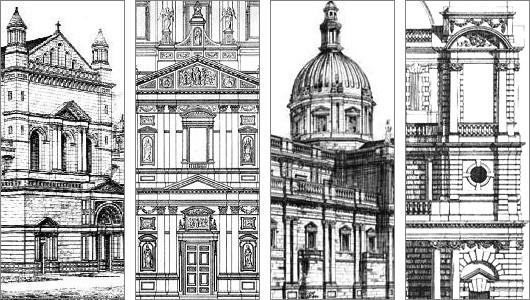
ARCHITECTURAL COMPETITIONS have always fascinated me because they give us the opportunity to glance at multiple executions for a single concept, to see different minds solve a “problem” with their own particular formulas and theorems. The designs of many of the world’s prominent buildings were chosen by competition, perhaps the Palace of Westminster — Britain’s Houses of Parliament — is most famous among them. When the Hungarian Parliament held a competition to design a grand palace to house the body, it found the top three prize designs so compelling that it built the first-prize design as parliament and the second and third places as government ministries nearby. To my surprise, I have only ever come across one book which adequately surveyed the subject of competitive architecture, Hilde de Haan’s Architects in Competition: International Architectural Competitions of the Last 200 Years. Most of the contests covered in the book are, naturally, for government buildings of national importance — private clients usually have a very firm idea of what they want and choose an architect accordingly.
One building not mentioned in the book but nonetheless very dear to me (and no doubt to many readers of this little corner of the web) is the Church of the Immaculate Heart of Mary of the Congregation of the London Oratory, more popularly known to friend and foe alike as the Brompton Oratory. It was the first church in Britain in which I ever heard mass, the summer after kindergarten when I was still but a tiny, blond-haired whippersnapper, in the midst of my first visit ever to the Old World, and the Oratory made quite a strong impression upon my young mind. It is usually one of my very first ports of call whenever I am in the capital, and I once even managed to slip in having just arrived at Heathrow while making my way to King’s Cross and the train to Scotland.
The Brompton Oratory is known for having good priests, traditional liturgy, and beautiful architecture. The final design was by one Herbert Gribble, but there was quite a bit of to-ing and fro-ing before Gribble was selected. The temporary church which had been erected on the site had been condemned by one critic as “almost contemptible” in its exterior design. In 1874, the Congregation of the Oratory (which is to say, the priests) put out an appeal for funds towards the construction of a permanent church. The 15th Duke of Norfolk obliged with £20,000 to get the ball rolling, and the next year a design by F. W. Moody and James Fergusson was agreed upon in principle. But the Reverend Fathers soon began to get creative and hatch ideas and contact other architects and very soon it was claimed that there were as many counter-proposals as there were priests of the Oratory, and perhaps more. A pack of clerics supported a suggested design by Herbert Gribble, but no accord could be reached among the Congregation as a whole.
In January 1878, then, it was announced that a competition would take place to decide the design of the permanent church of the London Oratorians. First prize was £200, with £75 for the runner-up. All entries had to meet the certain requirements drawn up by the Congregation. The style was to be “that of the Italian Renaissance”. The sanctuary, at least sixty feet deep, must be “the most important part of the Church. … Especially the altar and tabernacle should stand out as visibly the great object of the whole Church.” The minimum width of the nave was fifty feet, and maximum length 175 feet. Subsidiary chapels must be “distinct chambers”, not merely side altars. One aspect not mentioned was the projected execution costs of the designs — “an omission criticized by architectural journalists and disgruntled competitors,” the London Survey tells us, “whose designs called for expenditure ranging from £35,000 to £200,000”.
Over thirty entries were submitted to the competition, and Alfred Waterhouse was commissioned by the Fathers to provide comment on the submissions. Significantly, George Gilbert Scott, Jr. submitted a design, though I haven’t been able to get my hands on any depictions of it. Waterhouse praised it as “of no ordinary merit. … I feel that it is impossible to speak too highly of its beauty, its quiet dignity, its absence of all vulgarity and its concentration of effect around the high altar.”
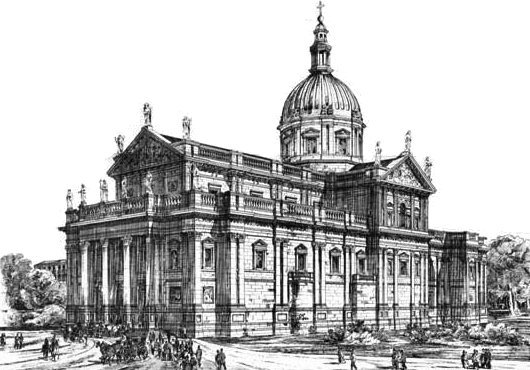
This entry was submitted by Albert Vicars & John O’Neill. Handsome in its own way, but rather staid and boring. The massing isn’t right, and the façade doesn’t work well.
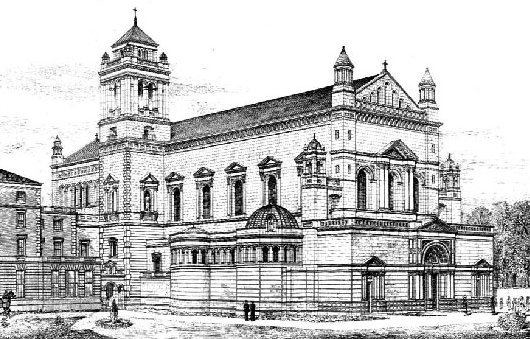
G. E. Grayson’s submission is completely lacking in focus. To my mind, it’s the kind of design Schinkel would’ve come up with if Schinkel hadn’t had any talent.
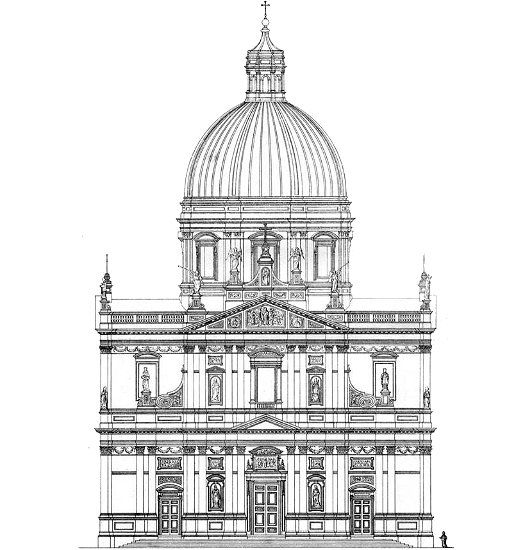
John Kelly’s proposal bears relation to the Vicars & O’Neill design, but the façade is much better, much more Roman. Those trumpets seem a bit gaudy, however.
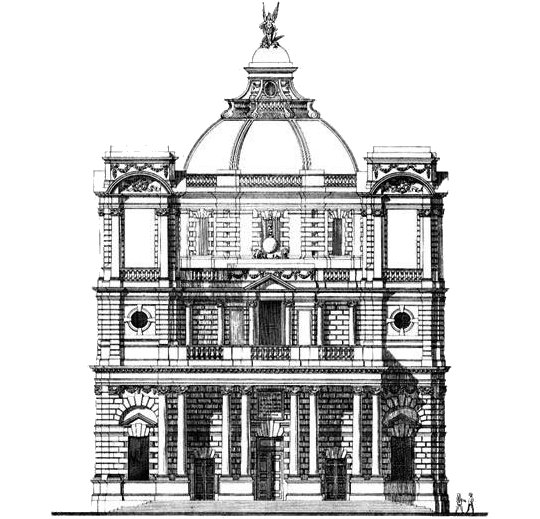
Second prize was awarded to the design of Henry Clutton, and the Fathers clearly knew what they liked since it bears a remarkable resemblance to Gribble’s first-prize entry: the massing and organisation of the interior is much the same. Clutton’s façade has a splendid base, but then a strangely small-in-proportion second storey. The influence of Saint-Sulpice is obvious, but this design pales in comparison to the Parisian church.
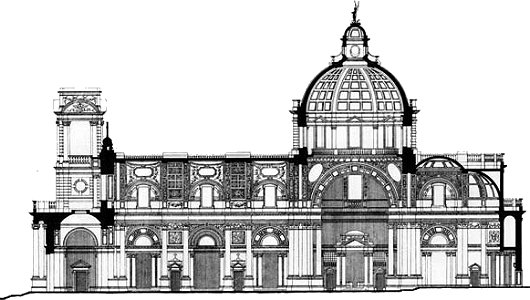
The spacial arrangements of the interior are, as I said, quite similar to Gribble’s winning design, which was executed. Clutton has a baldachin’d altar beneath the central dome, while Gribble’s plan placed a baldachin in the apse. Wisely, this aspect of Gribble’s proposal was never executed. The apse is not really large enough, nor properly fenestrated to allow for a baldachinno. Had it been built, the sanctuary would feel crowded, c.f. the Catholic Church in Rathmines, Co. Dublin for example.
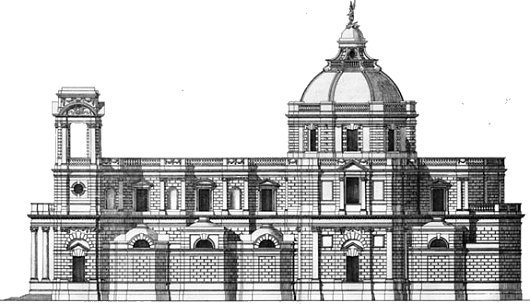
I’ve only seen a handful of the proposals submitted in the competition, but of those that I’ve seen it’s clear that the priests of the Oratory chose the best design. What’s more, they executed the design well, which is often half the battle. For what was built, the pilgrim or the passer-by can see on Brompton Road in Kensington. Here we have given you just a glimpse at the Brompton Oratory as it might have been — and, to be honest, as we’re rather glad it isn’t.
Search
Instagram: @andcusack
Click here for my Instagram photos.Most Recent Posts
- Gellner’s Prague December 19, 2024
- Monsieur Bayrou December 18, 2024
- Dempsey Heiner, Art Critic December 17, 2024
- Vote AR December 16, 2024
- Articles of Note: 12 December 2024 December 12, 2024
Most Recent Comments
Book Wishlist
Monthly Archives
Categories



This is great! Thanks Andrew
Call me staid and boring, but I like the Vicars & O’Neill–the grander scale of the ground floor order, and the more straightforward pediment.
According to this website:
http://www.bromptonoratory.com/history/page2.html
the facade at the south end (which would be the main facade, facing the street) was not added until 1893, design by Sherrin.
Thanks for this – have you read that great book “London as it might have been” by Felix Barker?
I like John Kelly’s design – it has both power and dignity.I find nothing wrong with the trumpeters – they seem to herald that the church has a great musical tradition.Where can I find designs for the interior?